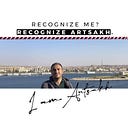Van Leo the Man Ray of Egypt
Van-Leo “Born Levon Alexander Boyadjian in November 1921’’ was Egypt’s premiere 20th-century studio photographer who became known for his numerous self-portraits and portraits of celebrities of his time such as Omar Sherif, Doria Shafik, and Taha Hussein.
Elevated portrait photography to new heights by creating imagery that accentuated his subjects’ features through the manipulation of lights and shadows, during the period from the late 1930s to the late 1990s.
He pursued art photography, most notably in a series of inventive self-portraits. His work also extended to producing commercial and travel images, as well as studio photography for everyday people, ranging from family and wedding portraits to passport photos.
Life and Career Path
He was of Armenian background and moved with his family from Turkey to Egypt in 1924. Levon’s primary and secondary school years were spent at Cairo’s College de la Salle (1931-1932) and the English Mission School (1932-1939). Enchanted by Hollywood and the world of cinema, Levon decided to put his studies on hold, after having enrolled in the American University in Cairo in 1940 to pursue his passion.
He undertook an apprenticeship at Studio Venus owned by a famous Armenian photographer named Arakel Artinian before opening his studio with his brother Angelo in January 1941, in the living room of their downtown Cairo family apartment. In 1947 Levon established his studio, he purchased the portrait studio Metro, located at 7 Fuad I Avenue from Kourken Yegorian for 450 Egyptian pounds – a price that included the equipment and furniture and where he worked until the end of his professional life. Later the name of the studio changed to “Studio Van Leo” by Boyadjian.
The combination of Hollywood-style glamour, romanticism, and sentimentality with electric eroticism, gave Van Leo’s portraits a truly artistic dimension that went beyond the scope of studio portraiture.
Alongside his commercial practice, his collection of self-portraits, created from his 20s to 40s is one of the largest of its kind in the world. Each self-portrait represents a character inspired by films, theatre, crime novels, news, and dreams. In their pastiche-like approach, they predate Cindy Sherman’s ‘Untitled movie stills’ by some thirty years.
The revolution of 1952
Despite ups and downs in his career, which resulted from changes in Egyptian politics and society and the commercialization of photography, Leo tried to maintain high standards and stay faithful to his art. During the first decade after 1952, he managed to keep his business afloat, However, his clientele largely dried out. Out of necessity, the art photographer had to resort to taking passport pictures, and wedding and family portraits. He was never motivated by money. His true passion was his art as announced on his business card, which read, “Van Leo-Art Photographer.”
The Van Leo Collection
On January 24, 1998, Van Leo took his last portrait, which was of photographer Barry Iverson and his wife Nihal. Leo announced the closure of the studio marking the end of an era. In April 1998, his work was chosen for preservation at the American University in Cairo. Fearing for the future of his negatives and prints, he decided at the encouragement of a friend and fellow photographer, Barry Iverson, to donate his entire corpus of work and equipment to the Rare Books and Special Collections Library at the American University in Cairo, which today houses “The Van Leo Collection”. In March 2002, Van Leo passed away from a heart attack at his apartment in Cairo at the age of 80.
